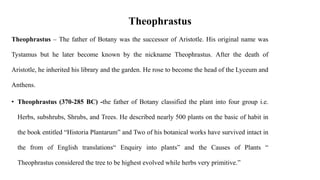
Theophrastus and carl linn.
- 1. Theophrastus Theophrastus – The father of Botany was the successor of Aristotle. His original name was Tystamus but he later become known by the nickname Theophrastus. After the death of Aristotle, he inherited his library and the garden. He rose to become the head of the Lyceum and Anthens. • Theophrastus (370-285 BC) -the father of Botany classified the plant into four group i.e. Herbs, subshrubs, Shrubs, and Trees. He described nearly 500 plants on the basic of habit in the book entitled “Historia Plantarum” and Two of his botanical works have survived intact in the from of English translations“ Enquiry into plants” and the Causes of Plants “ Theophrastus considered the tree to be highest evolved while herbs very primitive.”
- 2. • He also recognized the differences between flowering plants and non- flowering plants, superior ovary and inferior ovary, free and fused petals and also fruit types. He was aware of the fact that many cultivated plants do not breed true. Several names used by Theophrastus in Historia Plantarum e.g. Daucus, Asparagus, Crataegus and Narcissus which are in Use even today. His Classification was strictly artificial.
- 3. Carl Linnaeus (1707-1778) • Carl Linnaeus – Father of Taxonomy from the point of view of history of taxonomy. He is the creator of the modern system of nomenclature. He was the originator of the sexual system of classification in which he recognized 24 classes, mainly on the basis of number, length, union and certain other characters of stamens. He was the first to use consistently the “binomial system of nomenclature’ in which each organism is represented first by its generic name followed by the name of its species. He published a number of important work, eg.- Genera plantarum, Species plantarum, Flora Plantarum etc. in which he described hundreds of plants known in that time. His classification was strictly artificial.
- 4. The outline of Linnaeus System of classification with twenty four (24) classes is given: • Classes: • 1. Monandria (flowers with 1 stamen). • 2. Diandria (flowers with 2 stamens). • 3. Triandria (flowers with 3 stamens). • 4. Tetrandria (flowers with 4 stamens). • 5. Pentrandria (flowers with 5 stamens). • 6. Hexandria (flowers with 6 stamens). • 7. Heptandria (flowers with 7 stamens). • 8. Octandria (flowers with 8 stamens).
- 5. • 9. Enneandria (flowers with 9 stamens). • 10. Decandria (flowers with 10 stamens). • 11. Dodecandria (flowers with 12 stamens). • 12. Icosandria (flowers with more than 20 stamens are attached to the calyx). • 13. Polyandria (flowers with more than 20 stamens are attached to the receptacle). • 14. Didynamia (stamens didynamous). • 15. Tetradynamia (stamens tetradynamous). • 16. Monadelphia (stamens monadelphous). • 17. Diadelphia (stamens diadelphous).
- 6. • 18. Polyadelphia (stamens polyadelphous). • 19. Syngenesia (stamens syngenesious). • 20. Gynandria (stamens adnate to the pistil). • 21. Monoecia (plants monoecious). • 22. Dioecia (plants dioecious). • 23. Polygamia (plants polygamous). • 24. Cryptogamia (non-flowering plants i.e., cryptogams which include algae, fungi, mosses and ferns). • Due to simple and convenient approach, the Sexual System became very popular for more than 75 years before the publication of natural system by A. L. de Jussieu and A. P. de Candolle.
- 7. The merits and demerits of the Linnaeus system are: • Merit: • The only merit of this system is the quick and easy identification of plants based on one or a few characteristics. • Demerits: • 1. The system is not at all sexual in proper sense, but based only on numerical relationship of sex organs. Thus, it can be said that this system was developed on differences rather than on similarities of sex organs. • 2. The closely related members go apart and the distantly related members become very close to each other for the numerical relation of the sex organs. • 3. The Gymnosperms were placed in the 14th class Didynamia along with Labiatae, an angiosperm family.
- 8. • 4. The Monocotyledons, Dicotyledons and Gymnosperms i.e., phanerogamic plants are not considered separately. Thus, the members of Dicotyledons and Monocotyledons become very close, e.g., i. In the 1st class Monandria (flower having 1 stamen) – Globba (Zingiberaceae of Monocotyledons) and Mangifera (Anacardiaceae of Dicotyledons). • ii. In the 6th class Hexandria (flowers having 6 stamens) -Alisma (Alismaceae of Monocotyledons) and Rumex (Polygonaceae of Dicotyledons) come very close. Many other examples are also available. • Benson (1957) made the comment that “certainly it did not contribute anything directly to knowledge of plant relationships, but it did give a tremendous impetus to study of plant kingdom”.